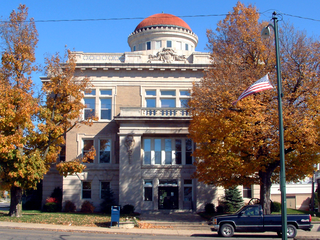
Warren County lies in western Indiana between the Illinois state line and the Wabash River in the United States. According to the 2010 census, the population was 8,508. The county seat is Williamsport.

Parke County lies in the western part of the U.S. state of Indiana along the Wabash River. The county was formed in 1821 out of a portion of Vigo County. According to the 2010 census, the population was 17,339, an increase of 0.6% from 17,241 in 2000. The county seat is Rockville.

The Miami are a Native American nation originally speaking one of the Algonquian languages. Among the peoples known as the Great Lakes tribes, it occupied territory that is now identified as North-central Indiana, southwest Michigan, and western Ohio. By 1846, most of the Miami had been deported to Indian Territory. The Miami Tribe of Oklahoma is the only federally recognized tribe of Miami Indians in the United States. The Miami Nation of Indiana is an unrecognized tribe.

Williamsport is a town in Washington Township, Warren County, in the U.S. state of Indiana. The population was 1,898 at the 2010 census. It is the county seat of Warren County and is the largest of the four incorporated towns in the county. Williamsport Falls is located in downtown Williamsport.

The Wabash River is a 503-mile-long (810 km) river that drains most of the state of Indiana in the United States. It flows from the headwaters in Ohio then southwest across northern Indiana turning south along the Illinois border where the southern portion forms the Indiana-Illinois border before flowing into the Ohio River. It is the largest northern tributary of the Ohio River and third largest overall, right behind the Cumberland and Tennessee Rivers. From the dam near Huntington, Indiana, to its terminus at the Ohio River, the Wabash flows freely for 411 miles (661 km). Its watershed drains most of Indiana. The Tippecanoe River, White River, Embarras River and Little Wabash River are major tributaries. The river's name comes from a Miami Indian word meaning "water over white stones".

Fort Ouiatenon, built in 1717, was the first fortified European settlement in what is now called Indiana. It was a palisade stockade with log blockhouse used as a French trading post on the Wabash River located approximately three miles southwest of modern-day West Lafayette. The name 'Ouiatenon' is a French rendering of the name in the Wea language, waayaahtanonki, meaning 'place of the whirlpool'. It was one of three French forts built during the 18th century in what was then New France, later the Northwest Territory and today the state of Indiana, the other two being Fort Miami and Fort Vincennes. A substantial French settlement grew up around the fort in the mid-18th century. It was ceded to the British and abandoned after the French and Indian war. Later, it passed into Indian hands and was destroyed in 1791 by American militia during the Northwest Indian War. It was never a U.S. fort. The original site was rediscovered in the 1960s and is now an archaeological site on the National Register of Historical Places.

Feast of the Hunters’ Moon is a weekend festival and historical reenactment held on a weekend in October since 1968, at the present-day site of Fort Ouiatenon, a replica 18th century French military and trading post near West Lafayette, Indiana. Traditionally, the Hunters' Moon is the full moon in October, following September's Harvest Moon.
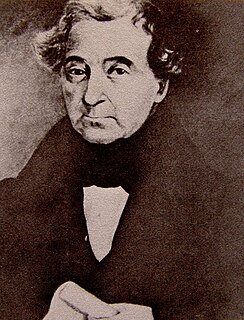
Jean Baptiste de Richardville, also known as Pinšiwa or Peshewa in the Miami-Illinois language or John Richardville in English, was the last akima of the Miami people. He began his career in the 1790s as a fur trader who controlled an important portage connecting the Maumee River to the Little River in what became the present-day state of Indiana. Richardville emerged a principal chief in 1816 and remained a leader of the Miamis until his death in 1841. He was a signatory to the Treaty of Greenville (1795), as well as several later treaties between the U.S. government and the Miami people, most notably the Treaty of Fort Wayne (1803), the Treaty of Fort Wayne (1809), the Treaty of Saint Mary's (1818), the Treaty of Mississinewas (1826), the treaty signed at the Forks of the Wabash (1838), and the Treaty of the Wabash (1840).

Adams Township is one of twelve townships in Warren County, Indiana. According to the 2010 census, its population was 512 and it contained 250 housing units.

Warren Township is one of twelve townships in Warren County, Indiana, United States. According to the 2010 census, its population was 806 and it contained 324 housing units.
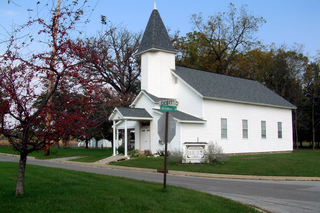
Independence is a small unincorporated community in Warren Township, Warren County, in the U.S. state of Indiana.
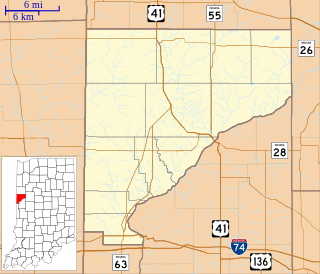
Warrenton is an extinct town in Warren Township, Warren County, in the U.S. state of Indiana. It was the county's original county seat.

Ouiatenon was a dwelling place of members of the Wea tribe of Native Americans. The name Ouiatenon, also variously given as Ouiatanon, Oujatanon, Ouiatano or other similar forms, is a French rendering of a term from the Wea dialect of the Miami-Illinois language which means "place of the people of the whirlpool", an ethnonym for the Wea. Ouiatenon can be said to refer generally to any settlement of Wea or to their tribal lands as a whole, though the name is most frequently used to refer to a group of extinct settlements situated together along the Wabash River in what is now western Tippecanoe County, Indiana.

The Potawatomi Trail of Death was the forced removal by militia in 1838 of some 859 members of the Potawatomi nation from Indiana to reservation lands in what is now eastern Kansas. The march began at Twin Lakes, Indiana on September 4, 1838, and ended on November 4, 1838, along the western bank of the Osage River, near present-day Osawatomie, Kansas. During the journey of approximately 660 miles (1,060 km) over 61 days, more than 40 persons died, most of them children. It marked the single largest Indian removal in Indiana history.

George Winter was an English-born landscape and portrait artist who immigrated to the United States in 1830 and became an American citizen in northern Indiana's Wabash River valley. Winter was one of Indiana's first professional artists. In addition, he is considered the state's most significant painter of the first half of the nineteenth century. Winter is especially noted for his sketches, watercolors, and oil portraits that provide a visual record of the Potawatomi and Miami people in northern Indiana from 1837 to the 1840s, as well as other figures drawn from his firsthand observations on the American frontier.
This article is a timeline of Warren County, Indiana history.

Wabash Township is one of thirteen townships in Parke County, Indiana, United States. As of the 2010 census, its population was 818 and it contained 353 housing units.
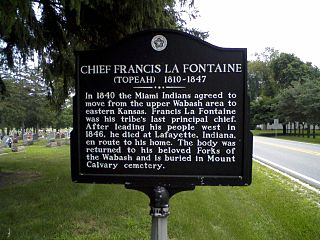
Francis La Fontaine, or Topeah was the last principal chief of the unified Miami tribe, and oversaw the split into the Western and Eastern Miami tribes.

Armiesburg is an unincorporated community in Wabash Township, Parke County, in Indiana.

Wyandot was a small town, now extinct, in Sheffield Township, Tippecanoe County, in the U.S. state of Indiana.




















